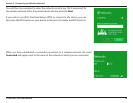
77D-Link DAP-1650 User Manual
Section 4 - Security
What is WPA?
WPA, or Wi-Fi Protected Access, is a Wi-Fi standard that was designed to improve the security features of WEP (Wired Equivalent
Privacy).
The 2 major improvements over WEP:
• Improved data encryption through the Temporal Key Integrity Protocol (TKIP). TKIP scrambles the keys using a
hashing algorithm and, by adding an integrity-checking feature, ensures that the keys haven’t been tampered
with. WPA2 is based on 802.11i and uses Advanced Encryption Standard (AES) instead of TKIP.
• User authentication, which is generally missing in WEP, through the extensible authentication protocol (EAP).
WEP regulates access to a wireless network based on a computer’s hardware-specic MAC address, which is
relatively simple to be snied out and stolen. EAP is built on a more secure public-key encryption system to
ensure that only authorized network users can access the network.
WPA-PSK/WPA2-PSK uses a passphrase or key to authenticate your wireless connection. The key is an alpha-numeric password
between 8 and 63 characters long. The password can include symbols (!?*&_) and spaces. This key must be the exact same
key entered on your wireless bridge or access point. WPA/WPA2 incorporates user authentication through the Extensible
Authentication Protocol (EAP). EAP is built on a more secure public key encryption system to ensure that only authorized
network users can access the network.
WPA/WPA2 has two main security levels; Personal, and Enterprise:
• WPA/WPA2 - Personal is sucient for most home networks and uses a pre-shared key as described above to
authenticate users and encrypt data.
• WPA/WPA2 - Enterprise is designed for medium-to-large scale networking environments and uses a centralized
RADIUS server for authentication. Users must be registered and authorized by the RADIUS server in order to
access the wireless network.


















